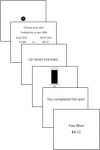An Examination of the Multi-Faceted Motivation System in Healthy Young Adults
- PMID: 29867611
- PMCID: PMC5958204
- DOI: 10.3389/fpsyt.2018.00191
An Examination of the Multi-Faceted Motivation System in Healthy Young Adults
Abstract
Background: Amotivation is a prevalent symptom in schizophrenia (SZ) and depression (MDD), and is linked to poor functional outcomes in affected individuals. Conceptualizations of motivation have outlined a multi-faceted construct comprised of reward responsiveness, reward expectancy, reward valuation, effort valuation, and action selection/preference-based decision making. To date, findings from studies utilizing variable-centered approaches to examining isolated facets of motivation in SZ and MDD have been inconsistent. Thus, the present study adopted a person-centered approach, and comprehensively examined the reward system in a non-clinical sample in an attempt to explore potential subtypes of motivation impairments, while minimizing the effects of illness-related confounds. Methods: Ninety-six healthy undergraduate students were evaluated for amotivation, schizotypal traits, depressive symptoms, and cognition, and administered objective computerized tasks to measure the different facets of motivation. Cluster analysis was performed to explore subgroups of individuals based on similar motivation task performance. Additionally, correlational analyses were conducted in order to examine inter-relationships between motivation facets, and relations between clinical measures and facets of motivation. Results: Cluster analysis identified two subgroups of individuals with differential motivation performance profiles. Correlational analyses revealed that reward responsiveness was associated with amotivation, depressive symptoms, and negative schizotypy. Further, significant inter-correlations were found between reward responsiveness and reward expectancy, as well as between reward valuation and effort valuation. Conclusions: Our results mark important steps forward in understanding motivation in a non-clinical sample, and guide future dimensional and comprehensive analyses of the multi-faceted reward system. It remains to be seen whether these patterns of results will be similar in clinical populations such as SZ and MDD.
Keywords: RDoC; amotivation; depressive symptoms; reward system; schizotypal traits.
Figures






Similar articles
-
Effort-based decision making in schizotypy and its relationship with amotivation and psychosocial functioning.Front Psychiatry. 2023 Feb 16;14:1123046. doi: 10.3389/fpsyt.2023.1123046. eCollection 2023. Front Psychiatry. 2023. PMID: 36873206 Free PMC article.
-
Association between cognitive function and performance on effort based decision making in patients with major depressive disorder treated with Vortioxetine.Compr Psychiatry. 2019 Oct;94:152113. doi: 10.1016/j.comppsych.2019.07.006. Epub 2019 Jul 24. Compr Psychiatry. 2019. PMID: 31404802 Clinical Trial.
-
Effort-Based Reinforcement Processing and Functional Connectivity Underlying Amotivation in Medicated Patients with Depression and Schizophrenia.J Neurosci. 2017 Apr 19;37(16):4370-4380. doi: 10.1523/JNEUROSCI.2524-16.2017. Epub 2017 Mar 10. J Neurosci. 2017. PMID: 28283562 Free PMC article.
-
Mechanisms Underlying Motivational Deficits in Psychopathology: Similarities and Differences in Depression and Schizophrenia.Curr Top Behav Neurosci. 2016;27:411-49. doi: 10.1007/7854_2015_376. Curr Top Behav Neurosci. 2016. PMID: 26026289 Review.
-
Effort-Based Decision Making: A Novel Approach for Assessing Motivation in Schizophrenia.Schizophr Bull. 2015 Sep;41(5):1035-44. doi: 10.1093/schbul/sbv071. Epub 2015 Jun 18. Schizophr Bull. 2015. PMID: 26089350 Free PMC article. Review.
Cited by
-
The NIMH Research Domain Criteria (RDoC) Initiative and Its Implications for Research on Personality Disorder.Curr Psychiatry Rep. 2019 Apr 27;21(6):37. doi: 10.1007/s11920-019-1023-2. Curr Psychiatry Rep. 2019. PMID: 31030293 Review.
-
The Moderation Effect of Approach Motivation Between Schizotypy and Creative Ideational Behavior.Psychol Res Behav Manag. 2024 May 9;17:1947-1960. doi: 10.2147/PRBM.S441013. eCollection 2024. Psychol Res Behav Manag. 2024. PMID: 38742225 Free PMC article.
References
LinkOut - more resources
Full Text Sources
Other Literature Sources

